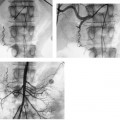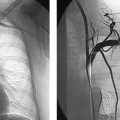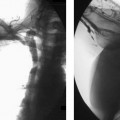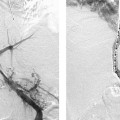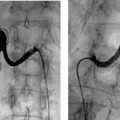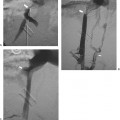CASE 13 A 47-year-old male who had received a kidney transplant 1 year earlier presented with refractory hypertension. Figure 13-1 Transplant renal artery angioplasty. (A) Digital subtraction angiogram shows high-grade stenosis of transplant renal artery. (B) Fluoroscopic image shows balloon dilation of stenosis. (C) Final digital subtraction angiogram shows alleviation of the stenosis. Renal ultrasound showed a velocity of 350 cm/s in the transplant renal artery. The left common femoral artery was catheterized using the Seldinger technique and a 5-French (F) sheath was inserted. The contralateral common iliac artery was catheterized over the aortic bifurcation with a 5F Rosch Inferior Mesenteric catheter (Cook, Bloomington, Indiana). A right pelvic angiogram was performed revealing a high-grade stenosis of the transplant renal artery (Fig. 13-1A). High-grade stenosis of the transplant renal artery. Five thousand units of heparin were administered intra-arterially. The renal artery was catheterized over the bifurcation using a 5F (Cook, Bloomington, Indiana) Inferior Mesenteric catheter and a Bentson guidewire. The catheter was then exchanged over a Rosen guidewire for a 6 mm- × 2 cm-long low-profile angioplasty balloon catheter. The stenosis was dilated at 6 to 8 atmospheres for 30 seconds (Fig. 13-1B). Follow-up arteriography (Fig. 13-1C) showed no residual stenosis with rapid antegrade flow to the kidney transplant.
Clinical Presentation

Radiologic Studies
Doppler Ultrasound
Renal Angiography
Diagnosis
Treatment
Equipment
Discussion
Background
Stay updated, free articles. Join our Telegram channel

Full access? Get Clinical Tree


